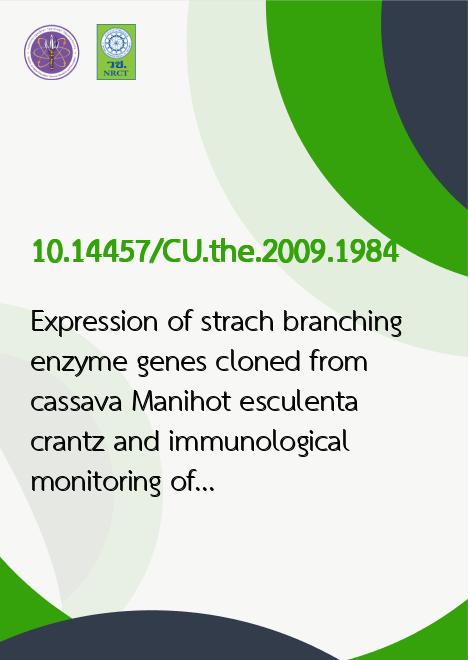
|
Expression of strach branching enzyme genes cloned from cassava Manihot esculenta crantz and immunological monitoring of the enzymes |
|---|---|
| รหัสดีโอไอ | |
| Title | Expression of strach branching enzyme genes cloned from cassava Manihot esculenta crantz and immunological monitoring of the enzymes |
| Creator | Surachai Yaiyen |
| Contributor | Tipaporn Limpaseni, Supatcharee Netrphan |
| Publisher | Chulalongkorn University |
| Publication Year | 2552 |
| Keyword | Gene expression, Cassava, Starch, Starch -- Synthesis, Enzymes |
| Abstract | Starch branching enzyme (SBE) also called Q-enzyme (alpha-1,4-glucan : alpha-1,4-glucan-6-glucosyltransferase, EC 2.4.1.18 introduces branch points in the amylopectin molecules by hydrolysis of the alpha-1,4-glucan chains. It catalyzes the formation of an alpha-1,6 cross linkage between the reducing end of the cleaved chain and glucose residue. In this study the cDNA of two SBE genes, sbeI and sbeII gene were cloned and expressed. Their respective PCR products were 2.8 and 2.7 kb were cloned into pET 28c for sbeI and pET 28b for sbeII. They were expressed in E. coli rosetta gami (DE). The optimum expression condition was induction with 0.4 mM IPTG for 4 hours for both transformants. Purification by Hitrap His-Tag chromatography resulted in 5 folds purification with specific activities of 8.4 and 7.6 units/mg protein, respectively. Both SBERI and SBERII showed similar characteristics: molecular weight of 90 kDa by SDS-PAGE, optimum pH at 7.0, optimum temperature of 37°C. However, their kinetic characteristics were different, Km and Vmax for amylose were 2.13 and 3.46 mg/ml and 1.7 และ 3.4 ΔA660/min for SBERI and SBERII respectively. SBERI was more active than SBERII towards amylose as substrate whereas SBERII was more active with amylopectin as substrate. Modification of tyrosine, argine and tryptophan altered the activities of both SBERI and SBERII whereas modification of histidine only affected SBERI. Comparison of amino acid compositions and kinetic parameters indicated SBE1 and SBE2 were similar to SBERI and were probably the product of sbeI gene while SBE3 was related to SBERII. Polyclonal antibody of each native isoforms could react with both recombinant enzymes and similar interactions were observed with polyclonal antibodies of recombinant enzyme and native SBE isoforms. Polyclonal antibodies of the recombinant enzyme were used to monitoring enzyme extract of tubers at different ages of 6, 9 and 12 months by western blots. Anti-SBERI stained more intensely with both bands of 108 kDa and 60 kDa. whereas anti-SBERII showed less intensity on both bands. The band intensities also increased with ages. |
| URL Website | cuir.car.chula.ac.th |